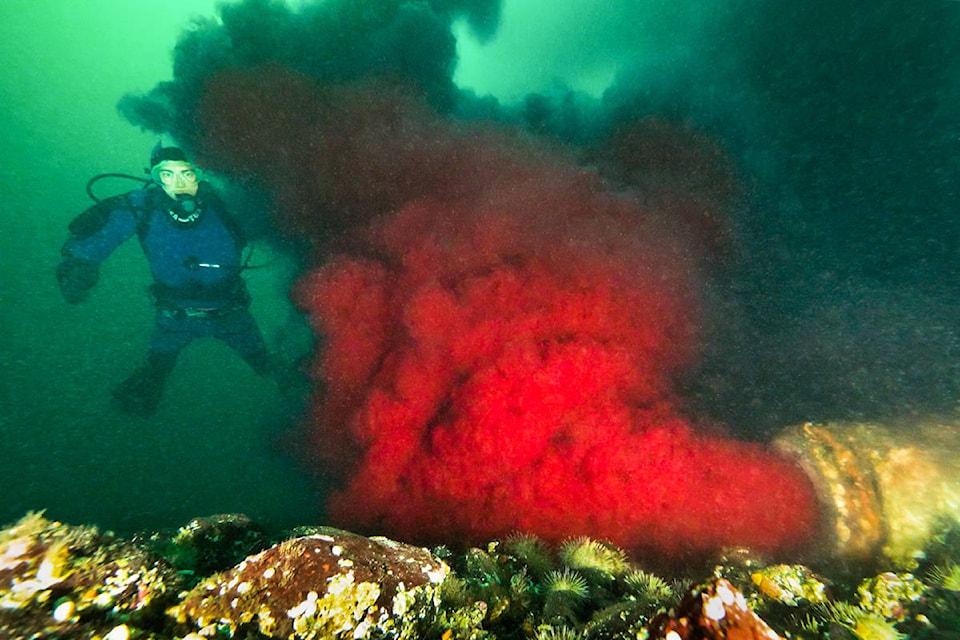Blood Water: B.C.’s Dirty Salmon Farming Secret from Tavish Campbell on Vimeo.
Billowing clouds of bloody water emitted from Vancouver Island salmon processing plants form the defining image of a video shot by Quadra Island photographer Tavish Campbell.
The video shows a fish packing plant in Brown’s Bay dumping what is being called “blood water” into the bay which is open to Discovery Passage north of Campbell River on Vancouver Island’s east coast. It also shows the same type of effluent being discharged from Lions Gate Fisheries’ plant into Tofino harbour on the Island’s west coast.
“It’s a pretty horrific thing to see,” Campbell said, “Just these huge billowing clouds of red blood water being released right into Brown’s Bay.”
The video, entitled, Blood Water: B.C.’s Dirty Salmon Farming Secret was produced by Campbell and published on the social media site Vimeo.
Campbell did two investigative dives at two farmed salmon processing plants on Vancouver Island – one at Brown’s Bay on the east coast of the Island and another at the Lions Gate Fisheries processing plant at Tofino on the Island’s west coast. Lions Gate Fisheries processes Pacific Chinook raised by its subsidiary, Creative Salmon.
Campbell shot the footage during three dives in April and October at Brown’s Bay Packing and in June at Tofino.
The April dive was done during the out-migration period for juvenile sockeye salmon from the Fraser River and other streams in the Salish Sea. Because Discovery Passage experiences tremendous tidal currents squeezing between Vancouver Island and Quadra Island, Brown’s Bay serves as a refuge for the migrating juvenile fish, Campbell said.
“Brown’s Bay acts as a bit of a holding pen for these small, little juvenile fish so that day – that very day we did the dive – when I got up from the dive you could see tons of these juvenile fish packed into the head of Brown’s Bay,” Campbell said. “It’s situated in such an unfortunate spot in terms of being right where these juvenile fish have to swim by.”
Campbell’s video shows a pinkish-red cloud being emitted by a pipe outlet from the plants. Campbell had the effluent tested and found evidence of Piscine Reovirus (PRV) which causes the disease HSMI. HSMI damages the heart and skeletal muscles of salmon. The samples he collected were sent to the Atlantic Veterinary College in Charlottetown, P.E.I. The testing was done by Prof. Fred Kibenge.
Campbell said the point of his video is not to demonize Brown’s Bay Packing or Lions Gate Fisheries. They are not doing anything illegal. The focus is on Fisheries and Oceans Canada (DFO) and their “inability to manage and regulate or protect wild fish,” Campbell said.
B.C. Environment Minister George Heyman is also aware of the video.
“We’re going to ensure, as we review the permit and put conditions on the permit if necessary, that any discharge into the water is safe from contamination,” he said.
“We’re hoping that can happen in the next few days. We’re also waiting for test results of the effluent that was taken some time ago, and if necessary we’ll conduct our own tests.”
These plants originally began as processing plants for wild fish but now handle farmed salmon as well. The PRV has been found in west coast salmon and is linked to HSMI, a potentially fatal disease for salmon.
To Campbell, the situation is another reason for a lack of confidence in DFO’s ability to regulate salmon farming on the West Coast and mitigate it’s impact on wild salmon stocks.
“Our wild salmon aren’t being looked after,” Campbell said.
And the clock is ticking on the situation in Brown’s Bay, he said.
“In a few short months the next wave of out-migrating juvenile fish is going to be coming up from the Salish Sea and from the Fraser (River) and having to pass right by the plant. It is something that we have to act on quickly.”
Companies say their effluent meets standards
Brown’s Bay Packing says it disinfects its effluent before it is released into the marine environment.
The company released a statement about the effluent:
“Browns Bay Packing Company, like all plants processing farm-raised Atlantic salmon in B.C., disinfects effluent before it is released into the marine environment. While the liquid discharged remains red in colour, the treatment process is designed specifically to treat for fish pathogens.
“The treatment of that effluent is to a level higher than Provincial standards for fish plants, and is governed by a Memorandum of Understanding (MoU) signed by all companies farming and processing Atlantic salmon. The MoU explicitly states that all plants will have a functional disinfection system in place, all water/ice, blood-water, wash-water and other wastewater within the processing plant will be collected and treated through the processing plant central treatment system, all blood-water and wastewater used during off loading and transport from the boat to processing plant will be contained and treated.
“The disinfection standards in the MoU are designed based on the Norwegian standard – which has been determined to be effective in in-activating fish virus’.
“Browns Bay Packing Company is also certified to the Global Aquaculture Alliance’s Best Aquaculture Practices standard. This is an audited, international standard, that also exceeds Provincial standards. The detailed BAP standard is available here.”
Lions Gate Fisheries also issued a press release about the video today on its website. It says:
“Lions Gate Fisheries, like all processing Pacific salmon – farmed or wild – on B.C.’s coast, operates its Tofino plant under permit from the provincial government.
“Effluent from the plant is screened and discharged into the marine environment at depth according to the provincial government permit.
“Lions Gate Fisheries processes Pacific chinook raised by Creative Salmon. Both the plant and Creative Salmon are certified to the Canadian Organic Aquaculture Standard. This is an audited, national standard that exceeds municipal, provincial and federal regulatory requirements.”
